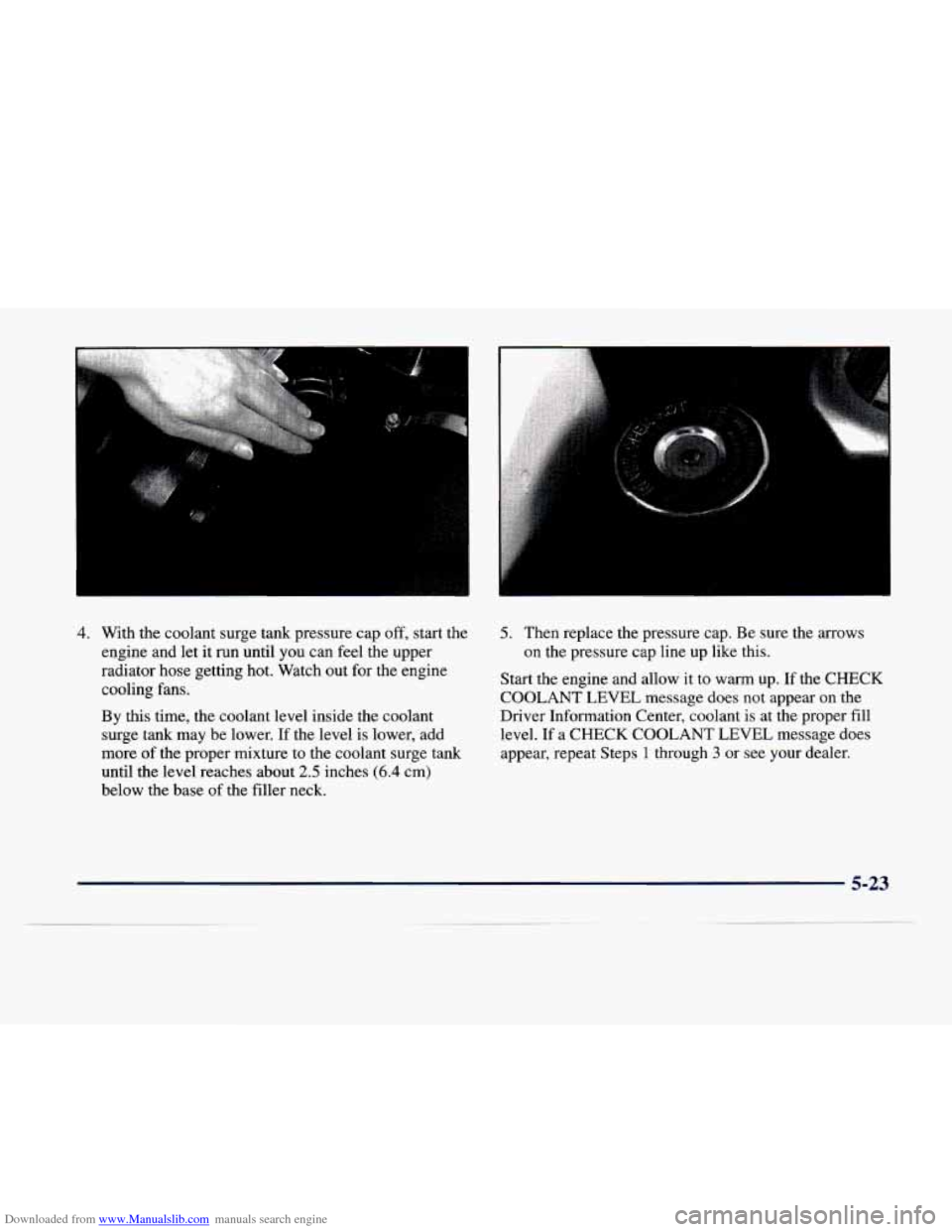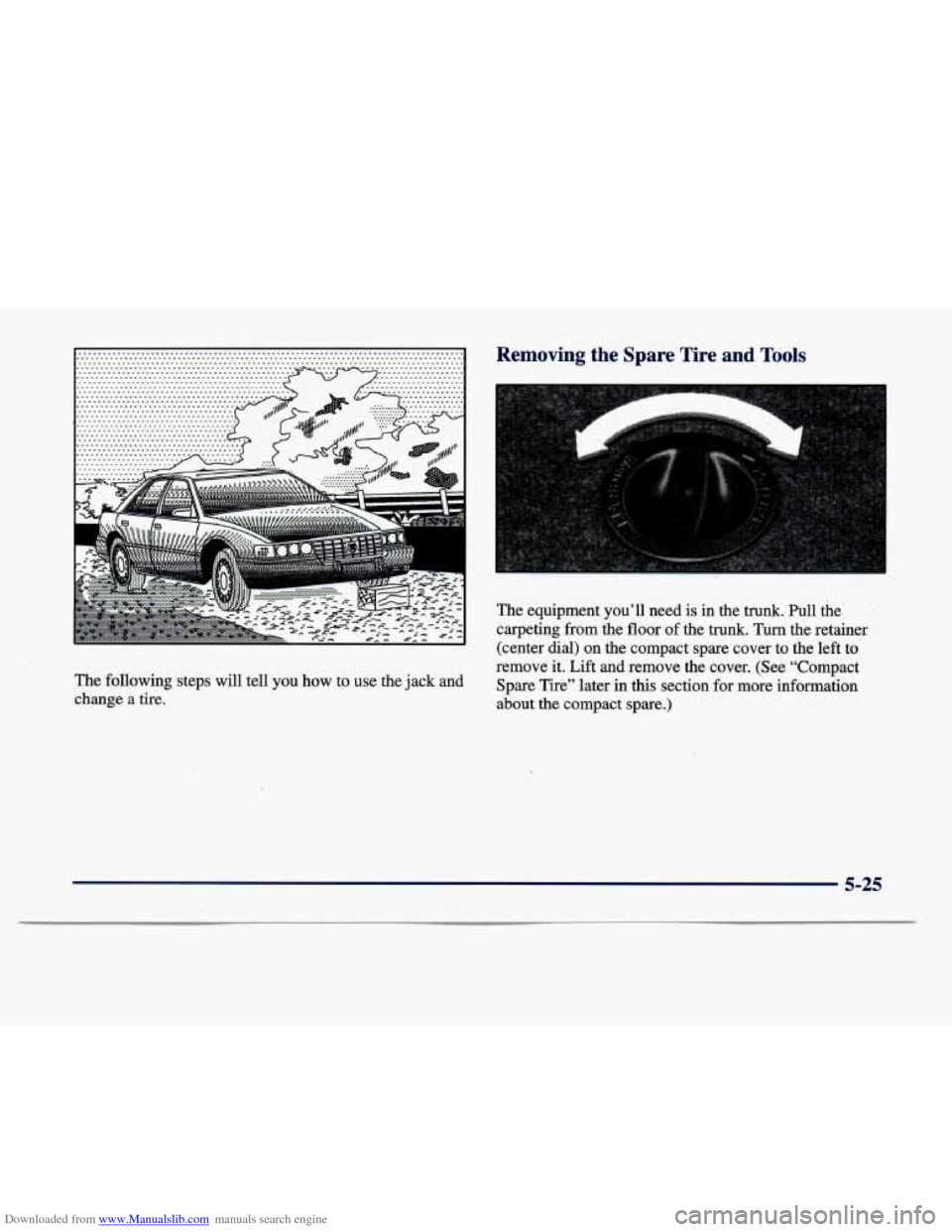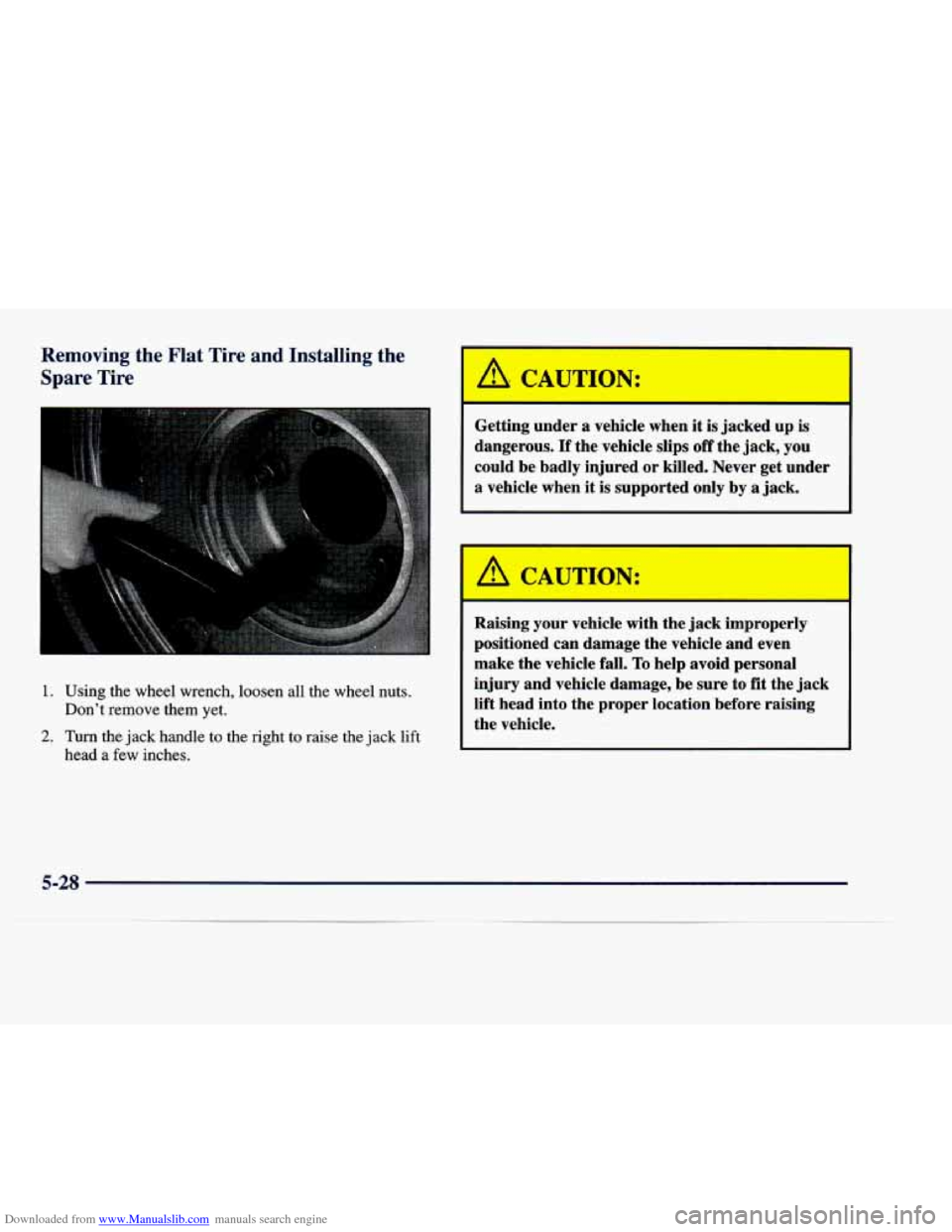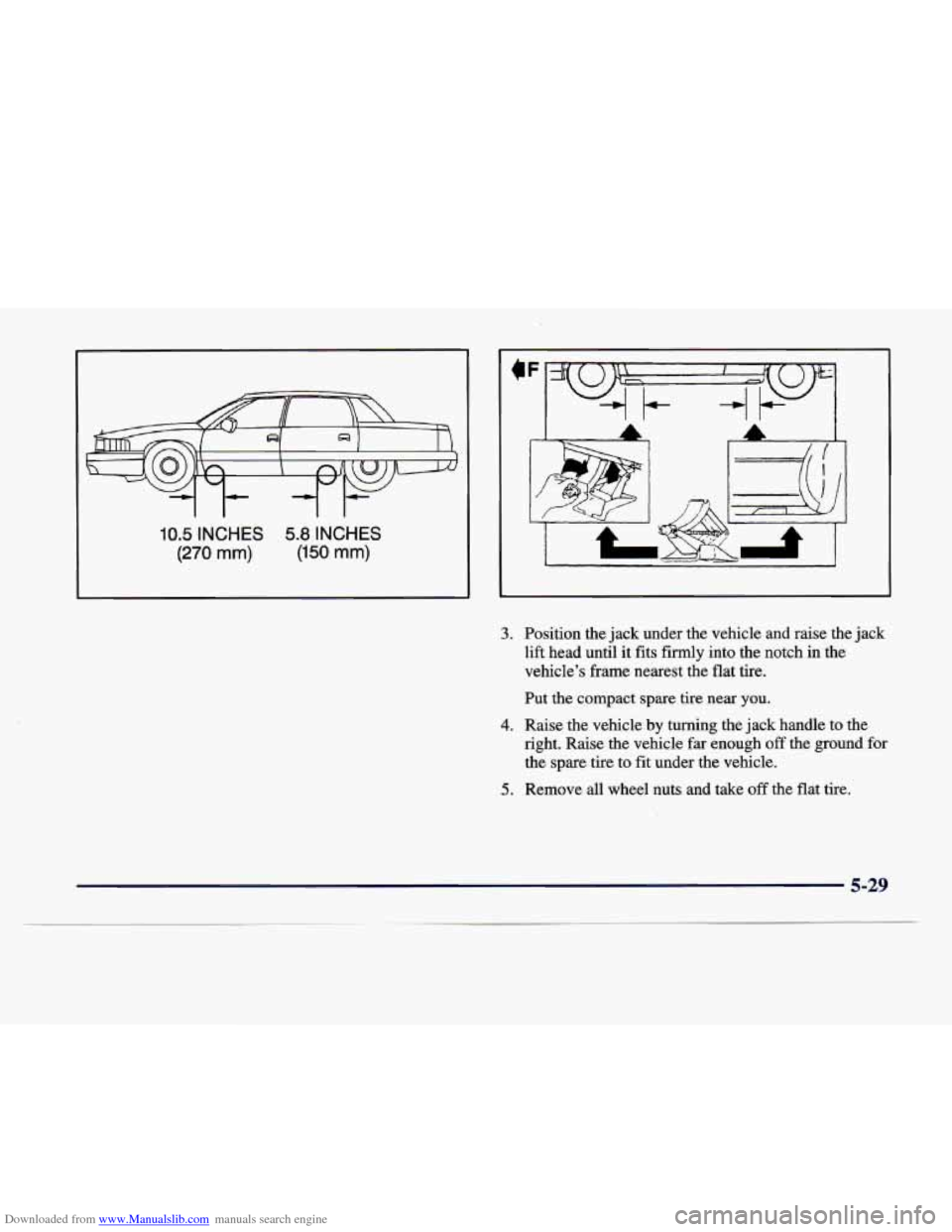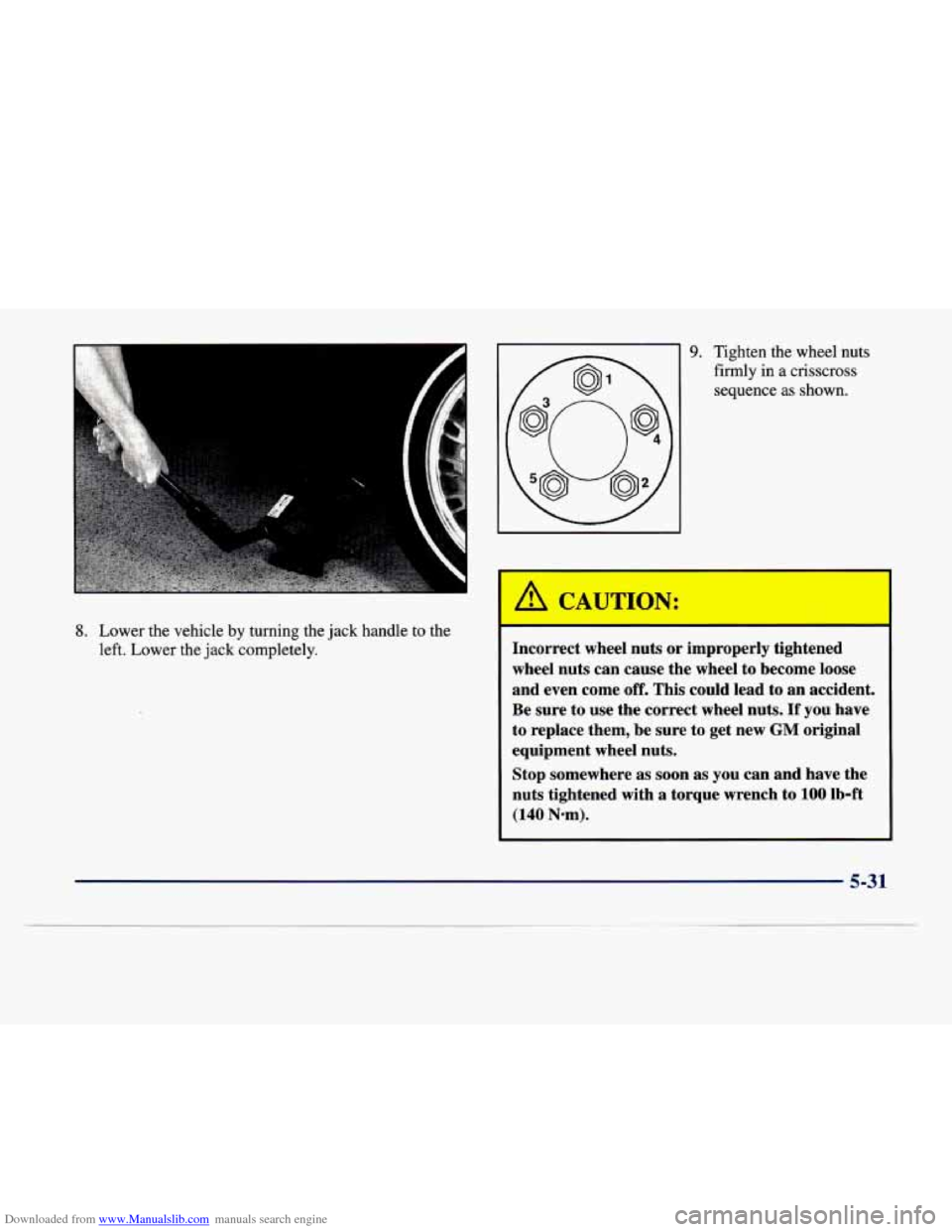CADILLAC DEVILLE 1998 7.G Owners Manual
DEVILLE 1998 7.G
CADILLAC
CADILLAC
https://www.carmanualsonline.info/img/23/7997/w960_7997-0.png
CADILLAC DEVILLE 1998 7.G Owners Manual
Trending: fuel reserve, stop start, oil capacity, air filter, wheel size, change key battery, key battery
Page 271 of 386
Downloaded from www.Manualslib.com manuals search engine 2. Then keep turning the cap, but now push down as
you turn it. Remove the pressure cap.
3. Then fill the coolant surge tar& with the proper
mixture, up to the base
of the filler neck.
5-22
Page 272 of 386
Downloaded from www.Manualslib.com manuals search engine 4. With the coolant surge tank pressure cap off, start the
engine and let it run until
you can feel the upper
radiator hose getting hot. Watch out for the engine
cooling fans.
By this time, the coolant level inside the coolant
surge tank may be lower.
If the level is lower, add
more
of the proper mixture to the coolant surge tank
until the level reaches about
2.5 inches (6.4 cm)
below
the base of the filler neck.
5. Then replace the pressure cap. Be sure the arrows
on
the pressure cap line up like this.
Start the engine and allow it to warm up. If the
CHECK
COOLANT LEVEL message does not appear on the
Driver Information Center, coolant
is at the proper fill
level.
If a CHECK COOLANT LEVEL message does
appear, repeat Steps
1 through 3 or see your dealer.
Page 273 of 386
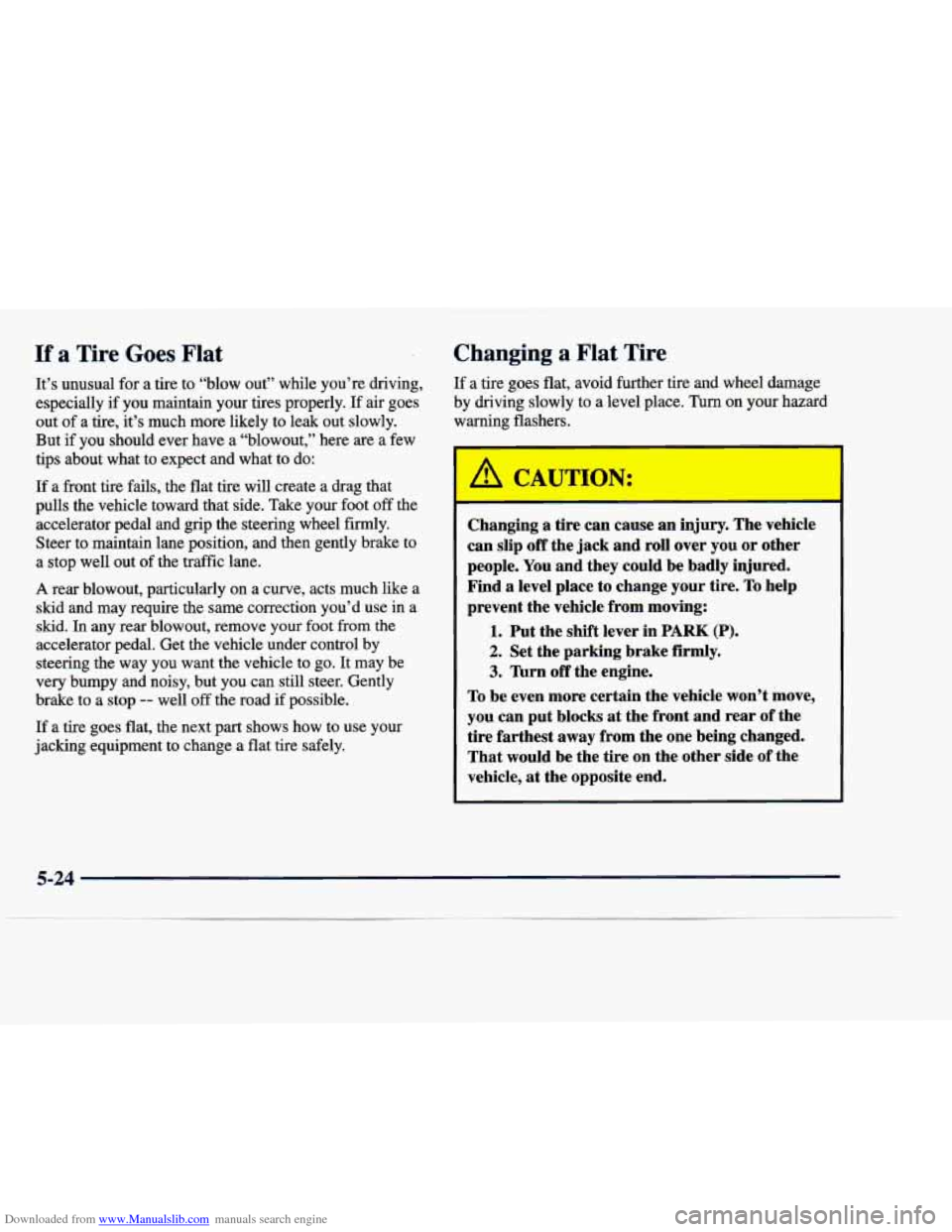
Downloaded from www.Manualslib.com manuals search engine If a Tire Goes Flat Changing a Flat Tire
It’s unusual for a tire to “blow out” while you’re driving,
especially if you maintain your tires properly. If air goes
out of a tire, it’s much more likely to leak out slowly.
But if you should ever have a “blowout,” here are a few\
tips about what to expect
and what to do:
If a front tire fails, the flat tire will create a drag that
pulls the vehicle toward that side. Take your foot
off the
accelerator pedal and grip the steering wheel firmly.
Steer to maintain lane position, and then gently brake to
a stop well out of the traffic lane.
A rear blowout, particularly on a curve, acts much like a
skid and may require the same correction you’d use in a
skid. In any rear blowout, remove your foot from the
accelerator pedal. Get the vehicle under control by
steering the way you want the vehicle to go.
It may be
very bumpy and noisy, but you can still steer. Gently
brake to a stop
-- well off the road if possible.
If a tire goes flat, the next part shows how to use your
jacking equipment to change a flat tire safely. If a tire goes
flat, avoid further tire and wheel damage
by driving slowly to a level place. Turn on your hazard
warning flashers.
Changing
a tire can cause an injury. The vehicle
can slip
off the jack and roll over you or other
people. You and they could be badly injured.
Find
a level place to change your tire. To help
prevent the vehicle from moving:
1. Put the shift lever in PARK (P).
2. Set the parking brake firmly.
3. lhrn off the engine.
To be even more certain the vehicle won’t move,
you can put blocks at the front and rear of the
tire farthest away from the one being changed.
That would be the tire
on the other side of the
vehicle, at the opposite end.
5-24
Page 274 of 386
Downloaded from www.Manualslib.com manuals search engine Removing the Spare Tire and Tools
The equipment you’ll need is in the trunk. Pull the
carpeting from the floor
of the trunk. Turn the retainer
(center dial) on the compact spare cover to the left to
The following steps will tell you how to use the jack and
change a tire. remove
it. Lift and remove the cover. (See “Compact
Spare Tire’’ later in this section for more information
about the compact spare.)
5-25
Page 275 of 386
Downloaded from www.Manualslib.com manuals search engine Lift up the tire to remove it from the trunk. Turn the nut holding the
jack and wheel wrench to the
left and remove
it. Then remove the jack and wrench.
5-26
Page 276 of 386
Downloaded from www.Manualslib.com manuals search engine Removing the Wheel Cover
‘.
The tools you’ll be using include the jack (A) and the
wheel wrench
(B).
There is a center wheel cover on the aluminum wheel.
Using the flat end.of the wheel wrench, gently
pry the
wheel cover
off. Be careful not to scratch the aluminum
wheel edge and don’t
try to remove it with your hands.
5-27
Page 277 of 386
Downloaded from www.Manualslib.com manuals search engine Removing the Flat Tire and Installing the
Spare Tire
1. Using the wheel wrench, loosen all the wheel nuts.
Don’t remove them yet.
2. Turn the jack handle to the right to raise the jack lift
head
a few inches.
A. CAUTION: I
Getting under a vehicle when it is jacked up is
dangerous. If the vehicle slips off the jack, you
could be badly injured or killed. Never get under
a vehicle when it is supported only by a jack.
A CAUTION:
Raising your vehicle with the jack improperly
positioned can damage the vehicle and even
make the vehicle fall.
To help avoid personal
injury and vehicle damage, be sure to
fit the jack
lift head into the proper location before raising
the vehicle.
5-28
Page 278 of 386
Downloaded from www.Manualslib.com manuals search engine 10.5 INCHES 5.8 INCHES
(270 mm) (150 mm)
1
3. Position the jack under the vehicle and raise the jack
lift head until it fits firmly into the notch in the
vehicle’s frame nearest the flat
tire.
Put the compact spare tire near you.
right. Raise the vehicle far enough off the ground for
the spare tire to fit under the vehicle.
4. Raise the vehicle by turning the jack handle to the
5. Remove all wheel nuts and take off the flat tire.
5-29
~-
Page 279 of 386
Downloaded from www.Manualslib.com manuals search engine 6. Remove any rust or dirt
from the wheel bolts,
mounting
surfaces and
spare wheel.
-
Rust or dirt on the wheel, or on the parts to
which
it is fastened, can make the wheel nuts
become loose after
a time. The wheel could come
off and cause an accident. When you change
a
wheel, remove any rust or dirt from the places
where the wheel attaches to the vehicle. In an
emergency, you can use
a cloth or a paper towel
to do this;
but be sure to use a scraper or wire
brush later,
if you need to, to get all the rust or
dirt off.
A CAJTION:
Never use oil or grease on studs or nuts. If you
do, the nuts might come loose. Your wheel could
fall
off, causing a serious accident.
7. Replace the wheel nuts
with the rounded end
of
the nuts toward the
wheel. Tighten each nut
5-30
Page 280 of 386
Downloaded from www.Manualslib.com manuals search engine 8. Lower the vehicle by turning the jack handle to the
left. Lower the jack completely.
9. Tighten the wheel nuts
firmly in a crisscross
sequence
as shown.
A 3
I A CAUTIO1 ~
Incorrect wheel nuts or improperly tightened
wheel nuts can cause the wheel to become loose
and even come off. This could lead to an accident.
Be sure to use the correct wheel nuts.
If you have
to replace them, be sure
to get new GM original
equipment wheel nuts.
Stop somewhere as soon
as you can and have the
nuts tightened with
a torque wrench to 100 lb-ft
(140 Nom).
5-31
Trending: battery capacity, oil level, tire pressure, low oil pressure, remote start, fuel, engine oil capacity

